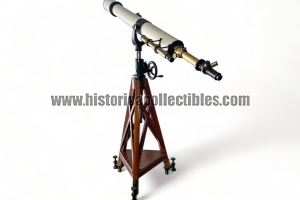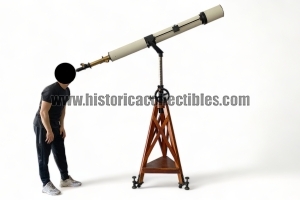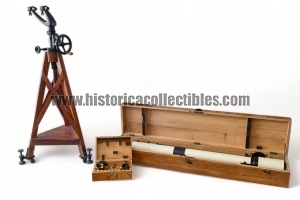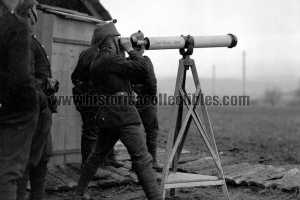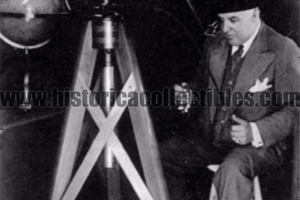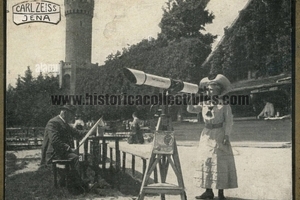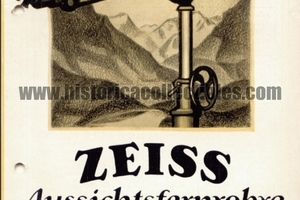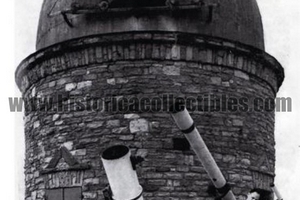Teleskop Refraktor Carl Zeiss Jena Mod. ASALUMEN (f=165 cm), circa 1910
Astronomical Refractor Telescope mod. ASALUMEN, produced by Carl Zeiss Jena around 1910, complete with its wooden pyramid tripod, with wheels and screw brake, action frame with rack and original wooden transport case.
In addition, there is also a Carl Zeiss finder scope. It also includes an original Zeiss wooden box in which various Carl Zeiss accessories are contained which at the time were "optional", therefore to be purchased separately from the refractor according to one's needs.
This exceptional refractor has a focal length of 165 cm, with an objective lens of 110 mm which corresponds to the "E" type, its revolver turret allows you to easily select magnifications.
This model of Refractor Telescope, given its technical and optical characteristics, offered the observer a very sharp and clear view, for this reason it had a very high cost, therefore intended for professional astronomers or wealthy personalities. Among the images present, Carlos Cardaldas is visible, founder of the Asociación Argentina Amigos de la Astronomía of Mackintosh.
Its storage conditions are exceptional, as are all its features.
Carl Zeiss takes its name from its founder, Carl Zeiss, who on November 17, 1846 chose the small city of Jena, in Thuringia, as the location for his precision optical equipment factory. Thanks to the strict quality control that Carl Zeiss imposed on its products, going so far as to personally destroy the microscopes that did not pass the tests, the newborn Zeiss became the official supplier of the University of Jena and received the gold medal of the industrial exhibition in 1861 of Thuringia as the best research instrument manufactured in Germany, awarded to the microscope Stand I of 1857.
In 1866, the thousandth microscope was produced and the Zeiss name became known in all European scientific circles. Thanks to the studies on the Porro prism, in 1893 Abbe patented a double prism binoculars, which accentuated the perception of depth.
The mass production of Zeiss binoculars began in 1894, already at the beginning of the twentieth century more than 30,000 were made, by the beginning of the First World War the figure had risen to 500,000 and, by the end of the Second World War, 2,260,000 were produced binoculars for the civilian and military market. Models were made starting from 4x11 mm to 12x40 mm, up to real giants such as 80 mm and 100 mm.
Thanks to studies conducted on the perception of light in low light situations, it was shown that the average dilation of the pupil in an adult is about 7 mm. For this reason, the 7x50 mm model was introduced in 1910 and remained on the market until 1917 with few changes to the materials used.
In 1926, following the post-war crisis of the First World War with the Treaty of Versailles which bankrupted many important German companies, Zeiss bought the "C.P. GOERZ" and founded the Zeiss Ikon in 1926.
In 1937, Zeiss had commercial contacts and factories spread over 29 countries around the world. From 1933 Zeiss acquired interest from the Nazi regime, which balanced production towards military instruments. It successfully produced binoculars with wide-angle optics for military use, pressure resistant optical systems for U-boats, periscope binoculars for targeting tanks. Furthermore Zeiss cameras were mounted on the V2 for remote sensing operations of the English coasts.
On November 1, 1935, Zeiss, in the person of Alexander Smakula, patented a process for the treatment of optical glasses with extraordinary results in terms of light transmission. Remained a military secret until 1939, it was adopted on binoculars to reduce ghost images and internal reflections. During the Second World War, there were numerous bombings against the Zeiss factories.
Jena was bombed several times by the Allies starting in 1944. Stuttgart was razed to the ground, although the Contessa-Nettel factory suffered little damage. The bombing of Dresden, in addition to devastating the city, also caused considerable damage to the Zeiss Ikon headquarters.
On April 13, 1945, American military forces entered Jena, surprising themselves as the bombings had not caused significant damage. The main planetarium was in ruins, while the factories remained operational.

